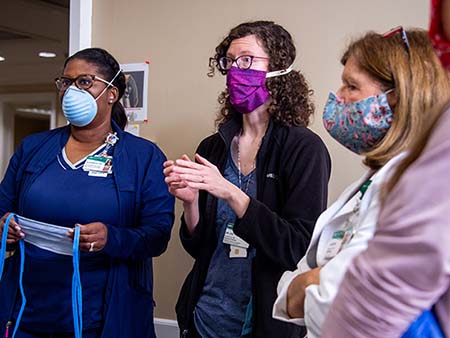
By Fletcher Allen
UAB News
Throughout the pandemic, people have had to adapt quickly to changes in recommendations from experts — start wearing masks, practice proper hand hygiene, implement social distancing, and more. While the Centers for Disease Control and Prevention has updated its masking recommendations to “two or more layers of washable, breathable fabric,” should people immediately jump to double masking?
“There is some evidence that two masks are better than one — specifically related to better filtration efficiency — and the data is really reflective of the fact some masks are better made than others,” said Rachael Lee, M.D., assistant professor in the University of Alabama at Birmingham’s Division of Infectious Diseases. “However, before we encourage people to wear two masks, it is more critical to communicate that people wear a properly fit, snug mask over their mouth and nose to prevent virus transmission. Even if people are wearing two masks, if they are not worn correctly, they are ineffective.”
In a recent study by the CDC, two methods of improving the fit of medical masks to reduce spread of infectious aerosols were tested. The first involved putting a cloth mask over a medical mask, and the second involved knotting ear loops in a medical mask. In both, the CDC used mannequin heads as either the source (infected person) or receiver (non-infected person).
The study found that improving the masking — double masks or a knotted and tucked mask — in the source reduced exposure of the receiver by 82 percent. When the source was unmasked and the receiver was wearing either of the two masking methods, the receiver’s exposure was significantly reduced compared to one mask alone. When both source and receiver were fitted with double masks or a knotted and tucked mask, exposure of the receiver was reduced 95 percent with both methods.
“These data from the CDC are important and underline the importance of mask wearing for everyone, regardless of symptoms,” Lee said. “This is particularly important in the community, where most of the population remains unvaccinated and where environmental conditions cannot be controlled. In the hospital, the single procedural universal mask provided by the health care system is appropriate for protection from exposure.”
The takeaway:
- At all times, it is critical to wear an appropriate mask that has at least two layers of washable, breathable fabric, covers your nose and mouth completely, fits snugly against the sides of one’s face, and bends to fit the nose.
- Wear one mask correctly first before layering a second mask.
- If you have access to appropriate masks, double masking is the most effective way to prevent transmission of COVID-19 at this time.
Appropriate glove usage
While cloth masks are more accessible and come in different sizes and fits, something that is in critical short supply is nitrile medical grade gloves. People are wearing these medical grade gloves to the grocery store or out in public, assuming that the gloves protect them from spreading the virus further. At this time, the CDC does not recommend that nitrile medical grade gloves be used in lieu of good hand hygiene.
The CDC does recommend that you should only wear gloves when caring for someone who is actively sick with COVID-19 or in disinfecting areas that an infected person is in contact with. The CDC does not recommend gloves “outside of these instances — for example, when using a shopping cart or using an ATM — as it will not necessarily protect you from getting COVID-19 and may still lead to the spread of germs.”
There are dangers associated with widespread use of gloves in place of hand hygiene, Lee says.
“There is a perception that gloves will protect your hands, but studies have shown that they are likely to decrease the usual triggers for hand hygiene; ultimately, this may actually increase the risk for contamination,” Lee said. “Additionally, there is a national shortage of gloves; thus, we should reduce unnecessary glove use where possible and leave those resources for frontline health care workers who desperately need gloves of this caliber for medical care.”
The takeaway:
- Medical grade gloves are not necessary to wear in everyday life as a means of protecting against COVID-19.
- Glove wearing does not replace the need to wash hands and practice healthy hand hygiene.
- The only appropriate instance to wear medical grade gloves outside of a health care setting is when caring for or disinfecting around a person with active COVID-19.
- Medical grade gloves are in short supply internally and are most needed by frontline health care workers at this time.



